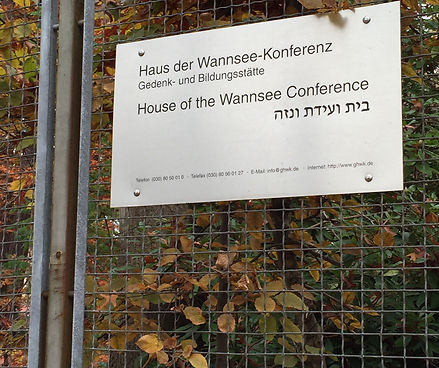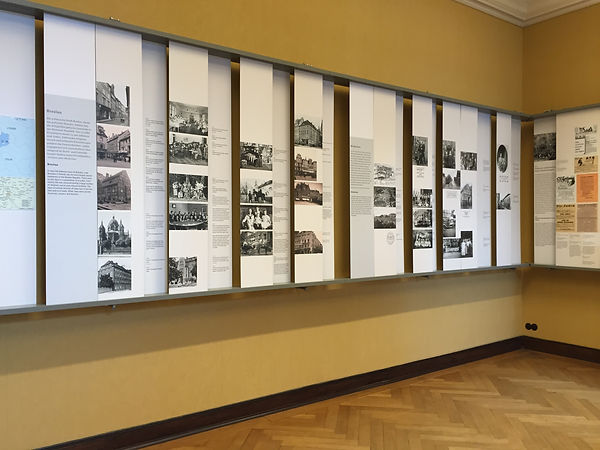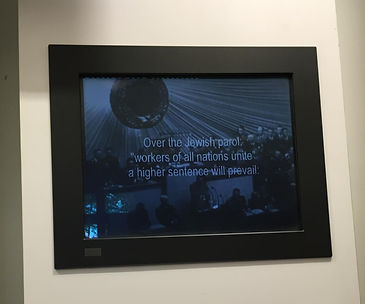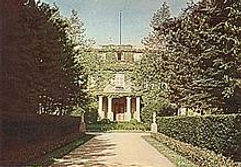
The House of the Wannsee Conference
The House of the Wannsee Conference is a permanent exhibition where the Final Solution was orchestrated and decided. The conference took place on 20th January 1942 and was headed by high-ranking Nazi officials led by Reinhard Heydrich. The infamous conference was arranged to organise the mass-murder of the Jewish people.
House of the Wannsee Conference was opened on the 50th anniversary of the conference on 20th January 1992. The permanent exhibition entitled ‘The Wannsee Konferenz and the Extermination of European Jewry’ chronicles the planning of the genocide of the Jewish European population and the events leading up to and during the Shoah. There are a range of archival documents including letters witnessing procedures to eradicate the Jewish population and documentation of the executions in the concentration camps. There are a series of wall panels featuring informative texts in every room alongside period photographs and listening posts. There is an overwhelming presence of bureaucracy that supported the process of eradicating the European Jews with copies of original Nazi correspondence, clearly illustrating how meticulous the Nazi Schreibtischäter were.
BACKGROUND

The Wannsee Conference House is predominantly a site of learning and is not as interactive as other memorial sites throughout Berlin. There are many rooms which are separated thematically and chronologically in terms of Nazi history.
The winding rooms in the villa lead to an ostentatious, opulent room with a view of the serene landscape of the grounds and the lake through the large glass windows. This room is a reconstruction of the space which held the discussions surrounding the Final Solution. The grand central room and the scenery it overlooks, are a paradox to the horrendous discussions which occurred in 1942. Presently, there are the minutes of the conference scribed by Adolf Eichmann, situated in the room, as well as photographs of the SS officers involved. The reality of standing in the same room where incomprehenable evil occured is an effective way of memorializing the events. It involves performing geographies as visitors experience entering the 'same' room as the SS officers, and demonstrates how place can evoke an emotional reaction. The history of violence is subsumed in this building and illustrates the way different sites have inherent acts of violence ingrained in the space.

A large part of remembering the Shoah is recognising the individuals who ultimately were stripped from human rights and became a statistic in the mass murders which occurred. The Wannsee House exhibit features four family biographies to portray and represent some of the faces to the millions who were persecuted and murdered. This connects people on a more personal level to the concept of the Final Solution as it starkly puts into context the inhumanity of the SS officials and the National Socialist ideals. The innocent families who were oppressed and tortured for simply being are a shocking realisation of how close the events that occurred in Wannsee House are, and the reality that the brutality took place in the same site that visitors are standing on. The clarity of the documents in the exhibit are alarming and alongwith the building represent the way different spaces and objects have acts of violence.
The Wannsee House serves as more than a memorial but as an exhibit with the aim of teaching visitors about the persecution and history of the Holocaust using real evidence: pictures, video clips, letters – really enlivens the chilling reality. The level of detail explored by visitors is optional on a continuum of a quick browse of letters and interactive multimedia teaching aids, or engross people in the large passages of text with detailed, factual information. Most of the text is available to read is in English, German and Ivrit (Hebrew) which demonstrates the acceptance of the Jewish people and recognition that many visitors will be Hebrew literate.


The way it is set up is very simple, but interesting, with lots of pictures and original documents and recording of speeches. Walking in the original rooms where the short meeting took place will impress you and make you quite. It is still hard to believe how this ever could happen. Located on the beautiful lake Wannsee, the contrast with the consequences of the decision that was taken inside of the building couldn't be bigger

Still the exibition is exemplary in showing all aspects of the holocaust in all its chilling details. you have to be very interested in the subject and willing to read a lot otherwise you are quickly bored or tired. But to stand in the actual conference room, read once more the copied pages of the protocol and then looking over the lawn to the lake is something that made me realize once more the almost surreal contradiction of horrors being contemplated and discussed as a matter or normal day to day business.

It is located in Wannsee in a really beautiful neighborhood, which makes the reality of the situation even more terrifying
A video of of the the Nazi Conferences showing real footage
TESTIMONIALS


RIGHT: THE CURRENT ROOM WHERE THE CONFERENCE WAS HELD. ABOVE: THE ROOM AROUND 1940
The House of the Wannsee Conference has become an institution of teaching- there are a multitude of classes which occur at the Wannsee House for studying the prehistory of the persecution of European Jews and the events occurring during the Shoah. There are study days where visitors can work with experts as well as seminars to interest adults engaged in political education or vocational teaching. In this respect the Wannsee memorial is largely different to the other memorials situated around Berlin to commemorate the Holocaust. It is very informative and clearly directs the course of thinking for visitors.
Similarly to the counter-monuments in Berlin, the Wannsee House evokes a range of reactions. There is often genuine anger at the callousness of Nazi behaviour and plans to murder the minorities in an attempt to purify Germany. Some countries further afield to Europe can be unaware of the happenings at the expense of the Jews by the Nazis, this can cause shock and outrage – the emotions indicate that this memorial is an experience. The room where the conference took place really brings to life the atrocities that occurred, especially in contrast to the idyllic setting of the peaceful lake and beautiful gardens. The Wannsee villa is an effect memorial in terms of both educating and commemorating the events in the Shoah. Although, unlike most the other memorials, the location of this site is geographically distant from the centre of Berlin, most people go to Wannsee House in order to learn about the Shoah and therefore come prepared to see the exhibit and have some prior knowledge. The direct link with the location of the villa on Wannsee Lake, a poignant building for Nazi officials, renders this space to be a key site of memory with inherent connections to the histories and geographies of violence.

THE VILLA, AROUND 1945

MAIN ENTRANCE, AROUND 1940

VIEW OF THE BACK OF THE VILLA, AROUND 1945

